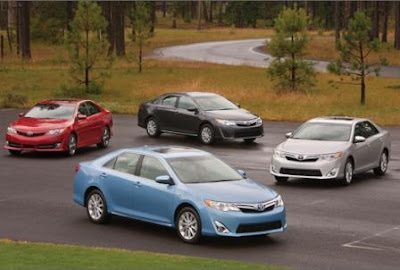
Since 1997, the Toyota Camry has been the best selling car in America every year but one (2001). Furthermore, the Camry platform serves as the foundation for the following Toyota and Lexus models: Avalon, Highlander, Sienna, Venza, ES350, RX350, and RX450h. Collectively, they added up to 738,415 sales in 2010—42 percent of To¬yota’s American total. Though Camry chief engineer Yukihiro Okane doesn’t say it, Toyota was perhaps embarrassed by losing out in mpg ratings to competitors, specifically the Ford Fusion hybrid and the Hyundai Sonata.
The base four-cylinder is now rated at 25 mpg city and 35 highway—up 3 mpg each.
Toyota achieved these improvements without direct fuel injection, downsized engines, or turbocharging. The hybrid loses an additional 66 pounds and gets a more efficient Atkinson-cycle engine with an electric water pump, more-effective regenerative braking, increased electric-motor usage, and better high-voltage-battery control. The hybrid benefits from a shrunken and relocated battery/electronics package, increasing trunk space from 11 cubic feet to 13. The SE would be our choice among the many models available (L, LE, SE, SE V-6, XLE, XLE V-6, hybrid LE, and hybrid XLE). Though there are still a multitude of Camry models, Toyota has substantially reduced the number of build combinations.
Would you believe that we once described the Toyota Camry -- the whipping boy of the enthusiast automotive media -- as "the gold standard of mid-size motoring?" Back in 1992, the Camry was Toyota's first mid-size car and the first one designed just for the American market. In the two decades since, the Camry's standard horsepower jumped 30 percent and torque more than 15 percent.
Because, even though each successive generation of Camry demonstrated improvements on paper, it became less appealing to car enthusiasts. Last year's Camry, like the 1992 edition that changed the game, was quiet, smooth, comfortable, and reliable.
The 2012 Camry's single biggest improvement is its interior. There's an unnecessary, but hugely welcome, band of contrasting thread stitched into the Camry's attractive, horizontally themed upper dash. Moreover, the Camry's liquid-butter driving experience is better than ever. The improvements come despite a significant weight loss (about 110 pounds versus last year's Camry) and additional equipment, including three more air bags, for a total of ten. The new four-cylinder Camry, meanwhile, jumps to the top of the class with expected 25/35 mpg ratings.
That highway rating matches the current Camry Hybrid's, which would be a problem for Toyota's marketing department if the 2012 Camry Hybrid didn't leap all the way to 39 mpg. In fact, combined fuel economy for the hybrid increases 25 percent, from a mediocre 33 mpg to a class-leading 41 mpg. Best of all, the Camry Hybrid is no longer painful to drive -- the soupy handling, artificial steering, bouncy ride, grabby brakes, and clumsy throttle response we complained about have all vanished without a trace. Why, yes, we just said that about a Toyota Camry.
We in the media gathered in Dearborn, LA, New York and Kentucky yesterday to simultaneously experience the official launch of the new, seventh-generation Toyota Camry, best selling car in the US for 13 of the last 14 years. The 2012 Camry will arrive in dealerships beginning the first of October. Camry Hybrid will come on line shortly thereafter.
The Camry’s profile, stance and ambiance are virtually unchanged. The slightly narrower C-pillar, modest lower body cladding, more stylish headlight and taillight designs, larger lower front fascia and other evolutionary fascia updates, distinguish the exterior. Information output and controls remain simple, though we thought the Hybrid should have more information and better graphics. Both 4- and 6-cylinder engines carry over from the current models: that means a tepid, but adequate 2.5-liter, 178-horsepower 4-cylinder, and a plenty strong 3.5-liter, 268-hourspower V6.
The Hybrid claims 43 mpg on the highway and 39 in the city with a combined 28 mpg.
The rear suspension geometry has been changed to improve ride and comfort as well as improve straight-line feel without compromising typical Camry ride characteristics. Toyota’s new Entune™ voice-activated infotainment system with a small variety of apps is available on the new Camry. Somehow they’ve added 2.5 cubic-feet of cargo space in the trunk. The base LE model starts down $200 from the current model at $22,500. We also agree with our colleagues that Toyota will do well with the new car as their deep well of loyalists and brand fans gobble up the new Camry.
No comments:
Post a Comment